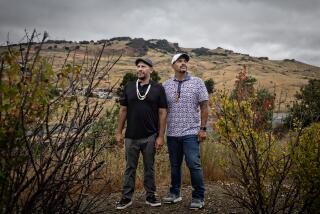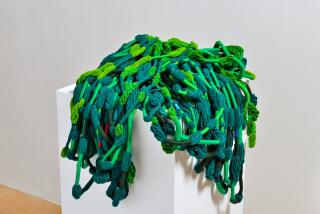Beauty of Pomo Indian Baskets Endures; Their Value Continues to Rise : Native culture: The weavers combined artistry with materials such as bird feathers and shells to create stunning works. The craft is still practiced.
- Share via
Appreciation of American Indian art, especially during the past 30 years, continues to rise. For the Pomo Indians of Northern California, however, their unparalleled artistry in basket weaving has created a demand for their work that has lasted more than a century.
“Since the 1880s, when Pomo baskets first became sought after, the Pomo have changed their lifestyles enormously,” said Dr. JoAllyn Archambault, director of the American Indian Program at the Smithsonian Institution’s National Museum of Natural History in Washington.
The Pomo--isolated groups of people who often spoke different languages and numbered in the thousands--once lived from the bounty of the land in a region north of San Francisco. Today, Archambault says, the remaining Pomo participate in society just like other Americans, yet “they still value and honor those among them who weave baskets.’
The baskets continue to carry high value. Pomo weavers combine artistry with natural materials, such as bird feathers and shells, to create baskets of stunning beauty. When white Americans became aware of these baskets in the 1870s, she says, the baskets immediately commanded high prices. Similarly, new Pomo baskets might sell for as much as $1,000. Today, the older baskets might sell for more than $10,000.
Scholarly studies of the first Indian basket craze, which lasted from about 1876 to the 1920s, Archambault says, are adding to understanding of the Pomo basketry tradition and the role it played in relationships between whites and Indians at the turn of the century.
“The number of Pomo basket weavers has decreased,” she said, “but not their skill and artistic vision. Basket makers usually have more requests than they can fill and many customers wait months before receiving their orders.”
To make their trademark sun baskets, the Pomo covered a basket completely with the vivid red feathers of the pileated woodpecker until the surface resembled the smoothness of the bird itself. With the feathers--30 to 50 to every inch--the Indians fastened beads to the basket’s border and hung pendants of polished abalone shell from the basket itself. Pomo women sometimes spent months or years making such gift baskets.
Pomo baskets were not only gifts, Archambault says. Baskets were central to Pomo life. Featherless woven baskets of different sizes and shapes were made mostly by women for a variety of purposes: Pomo children were cradled in baskets; acorns--a major food staple--were harvested in great conical burden baskets, and wickerwork fish traps and quail traps--made by Pomo men--helped furnish other seasonal foods. In fact, food was stored, cooked and served in baskets, some watertight.
A few Pomo groups lived in houses “constructed like huge coarse baskets with roofs that were virtually immense shallow inverted basket lids,” wrote Otis T. Mason, a late 19th-Century curator of ethnology at the Smithsonian’s Natural History Museum. Mason was one of the first Americans to take note of Pomo baskets, following the 1876 Centennial Exposition in Philadelphia. That exposition showcased some of the Indian cultures of the Western states and established widespread awareness of baskets made by those American Indians.
“By the turn of the century, middle-class white America was enthralled with Native American arts and crafts, especially basketry,” said Sherrie Smith-Ferri, an anthropologist who is completing her doctoral studies at the University of Washington in Seattle.
A member of the Dry Creek Band of the Pomo, Smith-Ferri participated in a recent scholarly forum organized by the National Museum of Natural History. She is one of a growing number of American Indians bringing a fresh perspective to studies of Indian art with the use of Smithsonian and other museum collections.
“Historic Pomo baskets are still sought after, admired, coveted, displayed and studied,” Smith-Ferri said. Major collections of these baskets can be seen at the National Museum of Natural History, the Smithsonian’s National Museum of the American Indian in New York City, the Field Museum of Natural History in Chicago, the American Museum of Natural History in New York and the Lowie Museum at UC Berkeley.
At the National Anthropological Archives of the Smithsonian’s Museum of Natural History, Smith-Ferri studied the correspondence between Mason and collectors in California--men such asW. Hudson of Ukiah, Calif., whose medical practice brought him into contact with Indians for almost 20 years. Hudson bought many Pomo baskets for the Smithsonian and other major Eastern museums.
“Following the movement of Anglo-American settlers into California in 1850,” Smith-Ferri said, “the Pomo people began to suffer drastic declines in population, severe cultural disruption, loss of homelands, oppression and conflict. Their hunting and gathering lifestyle was no longer viable, and they began working as laborers on white-owned farms and ranches that were their former homelands.
“Such was the backdrop against which the Pomo basket business began booming in 1890,” she said. “The archival correspondence paints a picture of three general types of dealers and collectors: amateur enthusiasts, buyers for curio dealers and scientific collectors. The first two groups usually visited the areas where the Pomo lived, quickly and indiscriminately bought baskets, and then left with their booty.
“Scientific collectors usually worked for museums,” Smith-Ferri said, “attempting to assemble documented collections of Pomo baskets with type specimens that were thought to be purely aboriginal. In contrast to the amateur enthusiasts or curio buyers, these collectors spent much more of their time with Pomo people. Some lived in towns near the Pomo.”
The “basket business, on the part of dealers and collectors, was very competitive, if not cutthroat,” she said. As demand increased, the baskets became more expensive. Hudson amassed a collection of more than 300 Pomo baskets, which he sold to the Smithsonian for $3,150 in 1898. He complained in an 1889 letter to Mason that “when the Pomo basket first made itself known and appreciated by lovers of Unique, baskets could be had for a few dimes.”
In 1892, Henry W. Henshaw, an ethnologist for the Smithsonian Bureau of American Ethnology, traveled to Ukiah to buy Pomo baskets for the Columbian Exposition in Chicago. “Tomorrow I shall try to get some baskets. The fine ones are out of reach--and I may have trouble in getting any. Speculators are here and will pay any price,” he wrote to a colleague in Washington, D.C.
According to Smith-Ferri, it became a common practice among collectors and dealers to commission baskets from the best weavers. In these contracts, the person commissioning the basket would often furnish the weaving materials, or pay weavers a small sum while they worked on baskets.
Even though the dealers and collectors exploited the lucrative basket market, “it still paid well enough to provide an important source of income to Pomo women at a time when hunting and gathering were no longer very feasible and other ways of survival were severely limited by the surrounding white society,” Smith-Ferri said.
Money aside, the high value Pomo Indians continue to place on their artisans, Archambault says, provides an important lesson for all Americans. Artists are to be revered for the beauty they create and the cultural knowledge they preserve and pass on to succeeding generations.


